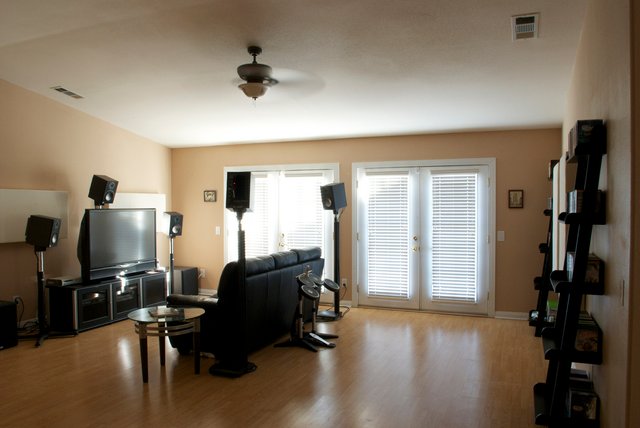
Many of us want to have such lovely homes that we spend thousands of dollars just to make sure that we are able to live comfortably. Aside from having a beautiful overall home design, home improvement may also include tech upgrades such as using smart home automation technology or installing the latest gadgets. Some people opt to set up their own home theater system, which we will talk about in this article.
The Home Theater System, in a Nutshell
One of the things that most modern homes incorporate into their new living spaces is a home theater system. It’s basically an audiovisual equipment arrangement that is patterned to a movie theater experience. In other words, it’s like having a smaller version of a cinema right in your own home.
If you love to watch movies or listen to music in high definition, a home theater system has the ability to bring world-class quality of entertainment. Instead of having to deal with long and crowded lines at a movie theater or a concert, you can relax and enjoy your favorite films or music artists through your own home theater system.
This kind of entertainment equipment package may come in various brands, models, and sizes. To guide you in buying the best home theater system, you may start by reading online reviews. If you have some ideas on trusted brands, you may visit appliance stores to test the different home theater systems available in the market.
Setting Up A Home Theater System
While having a home theater system can be a great way of enjoying different forms of media in the comforts of your house, some people may find the system setup to be a daunting task.
The good news is that it doesn’t have to be! Here are the things that you need for setting up your home theater system:
- Sound Meter (optional - but advisable)
- Connection cables and speaker wire
- Antenna, cable, or satellite Box (optional)
- Blu-ray/DVD/CD disc player or DVD/CD Player
- DVD recorder, DVD recorder/VCR combo, or VCR (optional)
- Home theater receiver (i.e. AV or surround sound receiver)
- Loudspeakers (number depends on speaker layout)
- Media streamer (optional)
- Subwoofer
- TV or video projector with screen
- Wire stripper (for speaker wire)
At its most basic setup, you need a TV, a Blu-ray Disc or DVD player, AV receiver, and media streaming device. You may add other devices and accessories to your home theater system according to your heart’s desire (and your budget).
Here are some tips to help you set up your home theater system properly:
- Starting with your TV, you have the option to connect the audio/video output of your cable/satellite box into your TV. Therefore, if you are using a Smart TV, make sure that you are connected to the internet as well.
- Your home theater receiver is the focal point of your home theater setup. It provides most of the connectivity, decoding, processing, and amplification to power your speakers.
- To maximize your enjoyment in watching movies, instead of just watching via Netflix, you may connect your Blu-ray Disc player to your home theater receiver via HDMI connections. Ensure that you rightfully configure your Blu-ray Disc Player Video and Audio Outputs with your home theater.
- Similarly, if you have a DVD player, connect one of the video outputs of your DVD player to the DVD player video input on your AV receiver. If your DVD player has HDMI connections similar to your Blu-ray Disc Player, then just connect it the same way. However, if it does not have an HDMI output, you will need a component video in combination with a digital optical or digital coaxial audio connection from the player to the AV receiver. To be able to access the digital surround sound, simply use the DVD player’s HDMI connections.
- Use available media streamers in the form of Amazon Fire TV stick or box, Roku, or Google Chromecast that allow you access to a wide range of channels via the internet. To access media streaming from these devices on your TV, you may connect it directly to your TV or to your home theater receiver using HDMI. However, to have the best quality of both audio and video, the media streamer should go directly through the home theater receiver.
More Tips To Maximize the Home Theater System
The home theater system is a hefty investment, but you can capitalize on its features through the following tips and tricks:- Use a high-end subwoofer. Most home theater systems are defined by the quality of the bass sound that it produces, and a good subwoofer brings this low sound with power.
- Experiment on the best place to put your speakers. It may not sound like much, but proper orientation of the speakers can make a huge difference in enjoying an immersive auditory experience.
- Keep your wires tidy and organized. What good is a beautiful home theater system if the wires are splayed all over the place? Make use of wire clips and wrap tubes to organize them properly. It will also keep your system safe from disconnections or people tripping over the wires.
- Upgrade your seats. While this isn’t necessarily part of the home theater system, it might be worthwhile to consider spending on more comfy seating furniture. You may not realize this, but a lush leather sofa or a reclining seat can already do wonders to your home entertainment experience.
Here’s a final word of advice: It’s highly recommended to use the same brand for setting up the whole home theater system. This eliminates any compatibility issues that may arise from using parts and components in varying brands.